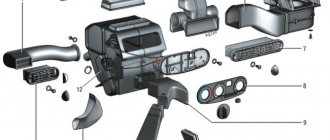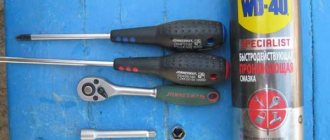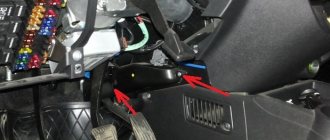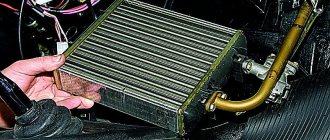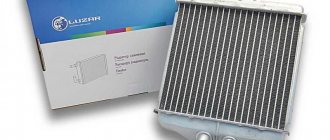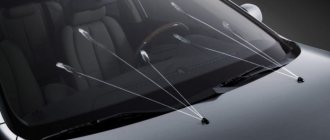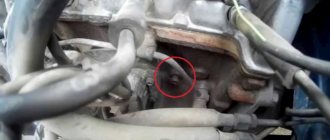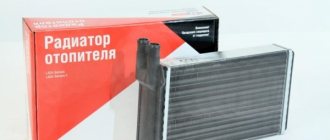A life hack from folk craftsmen - flushing the stove radiator with citric acid - is easy to do, even for an inexperienced driver.
You just need to clearly know the sequence of actions, and your stove will breathe deeply, warming the interior and passengers with the driver with renewed vigor. Why carry out such a procedure? Year after year, the stove in almost any car, especially an old one, heats up with less and less enthusiasm. And on cold winter days, when the temperature “outside” drops to -20°C, you really want warmth in the cabin. Sometimes, even when the engine reaches full operating temperatures, barely warm air blows from the grilles. And this is annoying, to say the least. In the cabin itself, steam comes out of your mouth. But if the system is properly cleaned, it will work like new!
Flushing the stove radiator with citric acid is usually carried out in several ways - by removing and without removing the unit.
As an example, let's take a “guinea pig” (more precisely, a Bear) – Mitsubishi Delica
. This car has a front heater and a rear heater with radiators, respectively. Removing the rear unit is quite simple, let's go through the procedure.
How to deal with it
The easiest way to get rid of this problem is to flush the stove radiator. Its essence is to drive a special agent through it that can dissolve and wash away all the scale and dirt. There are two cleaning methods: flushing the heater radiator without removing it from the car and with removal. The first method does not involve dismantling the heater. It is enough to simply disconnect it from the cooling system. In the second case, the heat exchanger is dismantled, and the entire procedure can be successfully carried out even in the bathroom. We will focus on the first option, since flushing the stove radiator without removing it is much easier. And considering that in some cars it is not so easy to get to the heater, it is also faster.
Heating system
The stove and bypass valve, integrated into the cooling system of the machine, are the main heating elements. The heater radiator is heated due to the high temperature of the engine coolant, which also enters the heat exchanger.
So if the pump is in order, the thermostat is working, the heater fan is not burned out, the air ducts are not clogged, the antifreeze level is normal and there is no air lock in the cooling system, then the cause of poor heating is contamination of the heater radiator.
This happens because all the dirt traveling through the system ends up in the heater radiator, gradually clogging its cells. Over time, this leads to a decrease in the temperature of the air entering the vehicle interior.
There are two ways to clean the heat exchanger: flushing the stove radiator without removing it from the car, and the same procedure, completely dismantling it.
How to rinse a stove radiator with vinegar without removing it
How to rinse a car radiator at home
You will need 3 bottles of 70% table vinegar, the capacity of 1 bottle is 180 g. Antifreeze for topping up is 1 liter, or replacing 5 liters. In the case of antifreeze mixed with sealant, it must be changed completely. The cleaning process begins with emptying the cooling system. The coolant is drained into a clean plastic bucket, 2 pipes are removed. The residue is blown out using a compressor. The heater is washed with water and purged with air. To avoid burns on the body from vinegar, wear rubber gloves and a protective mask. All vinegar is poured in for 4 hours. The machine is placed at an angle so that the vinegar fills all the “honeycombs”. They lift it with a car lift or by driving onto a hill or overpass. Bring the car to 5000 rpm for 5 minutes. This is how the air lock is expelled. The system is flushed under pressure. The results are visible at the bottom of the bucket. After washing, blowing with a compressor follows, the removed pipes are put on, new antifreeze is poured into the expansion tank or added to the old one. The engine starts and the coolant level is monitored.
Cleaning a car heater
We assemble a sequential circuit from the following elements:
- disconnected heater radiator;
- water pump;
- car battery or charger;
- container (bucket, canister, basin, etc.) with a chemical solvent;
- homemade filter.
Cleaning scheme
Hi-Gear special agent is used as solvents
or household “chemicals” such as
Tiret Professional
or
Mole
. A cheaper, but also effective option is to use citric acid bags in a proportion of 100 g per 3-5 liters of water.
Replacing filters during cleaning
Fill the resulting system with a preheated solution and start the pump. Periodically, it is necessary to clean the filter from several layers of bandage or mesh, secured with a clamp, from clogging. The entire operation lasts for 60-90 minutes. For greater efficiency, after running in one direction, we throw the hoses over and run the liquid in the other direction.
To ensure long-term maintenance of a high temperature during the process, you can lower the boiler into a container with liquid for a while.
Possible risks of using flushes
Each metal resists some aggressive substances and is helpless against others.
The dangers of flushing aluminum radiators with strong acids and alkali, which is part of sewer pipe cleaning products, have already been mentioned; it remains to be added that copper radiators cannot withstand everything.
In particular, even if the copper remains intact, the lead that is part of the solder on which the copper radiator is assembled really does not like some acids. The structure can be greatly weakened.
Copper itself is quite resistant to acid, but the problem is that foreign substances get into the solution. A situation is possible when copper begins to oxidize intensively, but copper oxide is washed off with acid instantly.
This way you can dissolve the entire radiator. Therefore, precise knowledge of which metals stand in the way of washing will allow us to first study the issue by finding out how actively they react with a particular composition. Not forgetting about nuances like solder and material of supply pipes.
Which heater should I wash it with?
Cars use radiators made of copper-brass alloy and duralumin.
These metals react differently to acid and alkali. Remember: a duralumin radiator cannot be washed with alkaline mixtures, and copper radiators with acidic ones. If you get it wrong, you can make the situation significantly worse. Therefore, before you wash the stove on your car, you need to find out what material it is made of. Universal products can be drinks like Coca-Cola and whey. The first one acts more aggressively and is capable of dissolving anything, while the second one, on the contrary, has a mild effect on the metal, but this does not reduce its effectiveness.
Radiator flushing with removal
Having decided what can be used to flush the radiator of a car’s heater, we begin the process itself. Regardless of the method chosen, the first step is to drain all the coolant from the system. After this, we dismantle the radiator along with the tap. We check the operation of the tap and clean the outside of the heater, removing dirt and dust from its lamellas. Before flushing, it is better to disconnect the tap.
Next, we rinse the radiator with a stream of water, directing it into one of the pipes. When the dirt stops coming out, tightly close any heater pipe, and fill the second with a pre-prepared solution. And it's better if it's hot. Leave the radiator to cool for about an hour.
After the specified time has passed, drain the cleaning agent from the heater and rinse it again with running water. For greater effect, you can use a hose by putting one end on the radiator pipe and connecting the other to the water supply. We rinse until dirt stops coming out of the heater. How effective the cleaning was can be determined by blowing into the connected hose. If air passes through the radiator channels freely, then our work was not in vain. All that remains is to screw on the faucet and install the heater in place.
Useful tips
After cleaning the heat exchanger, do not be lazy to replace the underwater hoses and install new clamps. After all, it will be very disappointing when, after a few days, the cabin becomes cold again, and the culprit is a small hole in the hose or a loose clamp that leads to air getting into the heater radiator.
Periodically clear the air ducts of leaves and dirt that could reduce the heating efficiency.
Use high-quality coolant to prevent re-contamination of the heater with impurities found in low-quality antifreeze.
Periodically turn on the fan at maximum speed to blow through the outer fins of the radiator.
With the onset of cold weather, car owners often find that their car's interior heating system is not working efficiently. Everything seems to be fine, but the air coming from the deflectors is not warm enough. This problem may be an indication that the car’s heater core is clogged and cannot pass the required amount of heated coolant through it.
What to do in such a situation: replace the heater or try to repair it? Do not rush to resort to radical measures. If the heat exchanger does not leak, it can be repaired.
In this article we will talk about how to flush the heater radiator without removing it from the car. In addition, we will discuss which products are best suited for this procedure.
Why does the heater radiator become clogged?
It is clear that a clogged radiator is not a normal phenomenon for a car and this phenomenon has a completely understandable reason. The thing is that during inactivity in the summer, the inner walls of the radiator tubes are subject to increased oxidation, since there is no circulation of liquid in the stove. The oxidation product settles on the walls and covers their entire area, while having the lowest thermal transfer coefficient. As a result, the copper or aluminum radiator tubes do not heat up and the heater blows cold air.
All these problems can be resolved using three different methods:
- Replace the heater radiator with a new one. An elementary way to get rid of many problems at once, but not the most economical, since the price of a new radiator is quite high.
- Wash the radiator after removing it from the car. This method is not associated with the cost of new spare parts and allows you to achieve maximum effect. However, it has one significant drawback - high labor intensity. Removing the heater radiator from the car panel is quite difficult.
- Flushing the radiator without removing it. The most economical and fastest option. Allows you to return the stove radiator to a working position without removing it. This is the method we will look at below.
How to clean radiator honeycombs?
To prevent the engine from overheating and the radiator from boiling, the first thing you need to do is clean the outer surface of the radiator. The Liqui Moly product - Kuhler Aussenreiniger - will help you with this. The composition must be applied to the honeycombs of a cold radiator and allowed to act for several minutes.
Interesting materials:
How to set up parental controls on Google Play? How to configure the router automatically? How to configure a router if it has a static IP? How to configure the Tenda f 300 router? How to configure a TP Link router after a reset? How to configure a router in repeater mode? How to configure a ZyXEL Keenetic router? How to set up your steering wheel for racing? How to set up Russian language on Huawei? How to set up Russian language in Telegram on iPhone?
Let's start the washing process
To begin with, by lifting the hood, we find two hoses that provide supply and drainage of fluid to the stove. Then:
- in the radiator fins. Having disconnected these hoses, we extend them, securing the joints with clamps and wrapping them with fum tape for tightness.
- Turning on the compressor, blow out the old antifreeze from the heat exchanger.
- Fill the radiator with diluted citric acid or another selected cleaning liquid, give it time, up to half an hour, to dissolve dirt and deposits. In more advanced cases, this time can be increased to several hours. Some people advise that before pouring, for greater effect, heat the solution to the operating temperature of the antifreeze, and in the case of using Coca-Cola, generally boil it.
- After the selected period of time, drain the liquid into a prepared container.
- This procedure must be repeated until no clear liquid comes out of the drain hose.
- By connecting the pump to one of the hoses, rinse the stove under pressure with clean water.
- By connecting the hoses back and adding antifreeze, you need to eliminate air in the system.
As an additional way to influence internal contaminants, some experts suggest connecting a pump to one of the hoses and lowering it into a bucket that serves as a container for draining liquid, driving the cleaning solution inside the stove in different directions. In order to evenly press all passages in the radiator plates.
Modern cleaning products
Replacing the radiator of the Priora stove
Effective flushing of the stove radiator is currently possible thanks to the auto chemical market, which offers a wide range of professional cleaning liquids. The main difference in the proposed “washes” lies in the active substance: acidic; or alkaline. Their use is determined by the “nature” of possible contamination: scale or grease deposits from the antifreeze used. In addition, acidic agents are intended for cooling systems with copper or brass radiator parts, and alkaline ones for aluminum ones. There are also neutral “washes” and two-component compositions. There are now a great variety of manufacturers of relevant auto chemicals: from famous brands such as Liqui Moli and Hi Gear to nameless products made in Russia and China.
Professional chemicals for flushing the stove radiator
Their use for washing car heaters without removal requires little preliminary preparation, and you will need a minimum amount of knowledge on the design of the cooling system. You will need:
- compressor;
- stove cleaner;
- clamps and fumlenta;
- hoses with adapters (corresponding to the hoses installed in the stove).
On-the-go preventative cleaning
This method is recommended to be implemented in the absence of frost - in summer, early spring or late autumn. The reason is to fill the cooling system of the power unit with distilled water for several days. Due to night frosts, heat exchanger tubes may crack due to ice expansion. It is permissible to carry out flushing activities in winter if the vehicle is stored in a warm garage and does not remain outside for a long time.
How to do this cleaning:
- Completely drain the engine cooling system.
- Take the required amount of distillate corresponding to the volume of the system. Heat the water and dissolve 100–150 grams of citric acid in it.
- Pour the product into the antifreeze area and make sure there are no air pockets.
- Ride in water with citric acid for 4-5 days, then drain the solution. Fill the engine cooling jacket and pipeline network with new antifreeze of a suitable brand.
Note. A food acid concentration of 100 grams per 10 liters of water is considered quite weak - the solution is unable to damage any parts or honeycombs of radiators.
Washing “on the go” is a preventative measure. A heat exchanger heavily clogged with scale cannot be cleaned using this method; a higher concentration of acid and backwashing are required.
Solution
It is known that citric acid is an excellent folk remedy for removing scale, for example, from the inner surface of teapots. No expensive means can compare! But, to be sure, you can pour 50 grams of Calgon into the solution in a bucket of water. And you need a lot of citric acid: 30 sachets, if you take 10-gram store-bought ones. Or - you can buy it by weight, three hundred grams is enough.
Dissolve all the citric acid in well-warm water (you don’t have to add Calgon if it’s not available). An actively acidic “hellish” solution was obtained. They need to be washed with a pump, but first they need to be warmed up strongly.
Ways to solve the problem
In order not to experience discomfort from the cold inside the car in winter, it is necessary to properly maintain the cleanliness of the cooling system. This will require a lot of effort from the car enthusiast. The main problem in servicing this system is that there is no universal means for cleaning the cooling system from both decomposition products of old antifreeze and corrosion products.
Here we can clearly see two sides of the same coin: acid solutions can easily deal with corrosion products, but they are useless for antifreeze residues (alkali is needed here). As you know from a school chemistry course, combining such products in one composition reduces their effectiveness to zero, because alkali neutralizes acid. As a result of this, we get a completely ineffective remedy.
We can draw a simple conclusion: most commercially available specialized chemicals for cleaning a car’s cooling system will not cope with this task fully, so it is necessary to service it in a timely manner so that you do not have to deal with additional difficulties.
How to understand that the reason is in the radiator
It is not difficult to diagnose a heater obstruction, especially if you are convinced that the water pump is working properly and the coolant is circulating in the system as usual. Warm up the car engine to operating temperature, open the heater tap and touch the radiator inlet and outlet pipes with your hand. If the difference in their temperature is tangible, it means that the coolant does not enter the heater or does not enter in full.
Next, you need to make sure that the problem is not in the radiator tap, because it also often fails. But if the faucet does not flow and closes and opens normally, most likely it is working properly, and the problem is specifically in the heater.
When diagnosing an obstruction of the heater radiator, the easiest way is to go to a service station, tell the specialists about the failure, and they will fix everything themselves. It's much easier than washing the stove radiator
yourself, but more expensive and longer. Is it worth spending money if a similar problem can be solved without the help of others, spending 30 minutes and a few 10 rubles on it? To do this, naturally, you should know how to clean and rinse a car stove at home. But first, let's look at the causes of the malfunction.
Why does the radiator get clogged?
The reason for poor quality work may be:
- If the car is driven most of the time in cold conditions with the heater running. Accordingly, the radiator channels gradually become clogged with dirt.
- Low quality products are used as a coolant. As a result, the metal radiator begins to oxidize and reaction products clog the heater cells.
- Using ordinary water with a high salt content as a remedy.
- Entry of foreign substances into the cooling system (fuel, oils, chemicals).
Cleaning the system involves removing dirt by washing it using various means: water, special means for flushing the radiator.
Risks to the engine due to improper cleaning
Where it's thin, that's where it breaks. A simple everyday law works in our case too. Let's assume that the flushing was successful and we removed all the grease and scale from the system. Naturally, with a well-maintained engine, and especially with low mileage, nothing bad will happen.
If the engine has not digested the highest quality oil and antifreeze, it is likely that something will go wrong:
- The pump is leaking. If this happens during or after flushing, it is worth remembering when the pump was last replaced. Most likely, its resource has already been exhausted. The only thing that saved the pump from leaking was the presence of dirt and scale on the bushing or oil seal.
- After cleaning, the stove started leaking. The situation is approximately the same. The scale on the honeycomb prevented the antifreeze from penetrating outside. This can also happen due to the use of suspicious cooling system sealants. We talked about the pros and cons of their use here.
- Leaks in pipes and hoses begin for the same reasons. The composition of the flushing fluid and the technology that we offer can in no way affect the integrity of the hoses and the tightness of their connection to the thermostat housing, cylinder head or radiator.
- The head gasket was blown. The most unpleasant story, but the root of the evil is also in the neglect of the system. Most likely, the gasket had already burned through, but washing removed soot and deposits, which stopped the gasket breakdown.
In general, if the engine was in good condition before flushing and good antifreeze was used that complies with the manufacturer's tolerances, there should be no side effects from such a flush.
The best option for washing and replacing antifreeze is a stand for vacuum fluid replacement.
Pump
{banner_content}No, you can, of course, wash it manually, using a watering can, funnel, or bucket.
But this procedure will require a lot of effort and twice as much time. Of course, this can be done better and more efficiently using an electric pump. Any one will do, even if it’s not powerful enough (for example, from an old washing machine). The main thing is that it creates circulation of the flushing liquid. Yes, and we will also need containers where the rinsing will drain and be pumped from. And – adapters for connecting the pump directly to the radiator. If the hoses available in size do not fit, then we use improvised means: “flexible wiring”, wire, tape, electrical tape, clamps, for example.
The main thing is that the supply hoses are mounted or screwed tightly onto the inlet and outlet of the radiator. Then success is guaranteed, and you won’t flood everything around with rinsing. It is also advisable to use a blowtorch to heat the solution or an electric stove.
FAQ
What is the best way to clean a copper stove radiator?
The simplest method for flushing a copper car heater radiator is to use a 10 percent caustic soda solution (caustic soda, mole for flushing plumbing pipes). The hot solution is poured inside for 30 minutes, then drained. If necessary, repeat the procedure two or three times. Washing with a mixture of citric acid and vinegar also shows good results. However, for an old copper radiator, it would be best to remove, unsolder it and mechanically clean it by hand.
What is the best way to clean an aluminum stove radiator?
To wash aluminum stove radiators, it is recommended to use acid-based products. The best options are whey, citric acid (such mixtures should only be very hot - 90°C) or phosphoric acid solution (heat to 40-50 degrees). And for a copper-brass heat exchanger, only professional products designed for flushing a car’s cooling system will be safe.
How to wash and what proportions for flushing the stove radiator with citric acid?
The proportion for flushing the radiator of a car heater with citric acid is 50 grams of acid per five liters of water. If the radiator is heavily clogged, the amount of acid can be increased to 80 grams. The acid is poured into 0.5 liters of boiled water, stirred until dissolved and then the bulk of distilled water is added. The liquid is poured into the cooling system instead of antifreeze, the engine is warmed up to operating temperature, and then left to idle for another 15 minutes. Then drain and wash the system 3-4 times with distilled water.
How can I clean the heater radiator without removing it?
Alkaline, acidic or special cleaners are used to flush car interior heater radiators. Alkaline compounds remove scale (lime), and acidic compounds remove rust.
How much does it cost to flush a stove radiator at a service center?
It is necessary to understand that different services, including in different cities, may charge different prices for the service of cleaning the stove radiator without dismantling it. However, as of the summer of 2022, on average, the price of this procedure starts from 1,500 Russian rubles. As for the procedure time, it is about two hours. If the radiator is severely clogged, it may take more time, and the payment will increase, since more cleaning products and worker time will be spent.
Do no harm
Independently flushing the heater radiator without removing it from the car or with removal is not the point; it must take into account the properties of the material from which the element being washed is made. Under no circumstances should you use alkaline solutions to clean aluminum heaters. The metal will instantly begin to oxidize, and the situation will only get worse. The same thing will happen if you pour acid into a copper radiator. Therefore, for aluminum - acidic agents, for copper - alkaline.
Universal remedies include Coca-Cola or Fanta heated to a boil, as well as whey, which has a “mild” destructive effect on scale.
If special liquids for flushing the cooling system have instructions for use, then with household powders, citric acid and soda you need to be extremely careful and know the proportions for preparing the solution.
